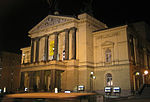Muzeum (Prague Metro)

Muzeum (Czech pronunciation: [ˈmuzɛ.um]) is a Prague Metro station providing the interchange between Lines A and C, and serving the National Museum. It is located at the top end of Wenceslas Square. The Line C station was opened on 9 May 1974, with the first section of Prague Metro, between Sokolovská and Kačerov. It is a single hall station, 194 metres (636 ft) long and only 10 metres (33 ft) deep. Two escalators and a staircase go to the vestibule.The Line A station was opened on 12 August 1978 as part of the inaugural section of Line A, between Leninova and Náměstí Míru. It is a three-bore station with a shortened, 69-metre (226 ft) middle tunnel. It is 108 metres (354 ft) long and 34 metres (112 ft) deep. The station at Line A was damaged during the 2002 floods and station at Line C was terminus.
Excerpt from the Wikipedia article Muzeum (Prague Metro) (License: CC BY-SA 3.0, Authors, Images).Muzeum (Prague Metro)
Muzejní oáza, Prague Vinohrady
Geographical coordinates (GPS) Address External links Nearby Places Show on map
Geographical coordinates (GPS)
| Latitude | Longitude |
|---|---|
| N 50.0796 ° | E 14.4312 ° |
Address
E6
Muzejní oáza
121 32 Prague, Vinohrady
Prague, Czechia
Open on Google Maps








